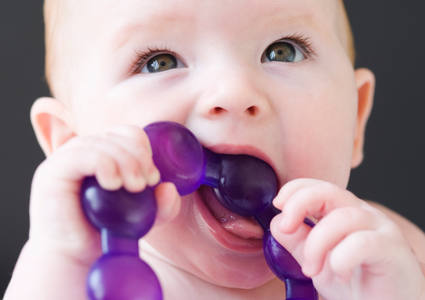




Family Health
Surviving Baby's First Tooth


There are many exciting milestones in your baby’s first year of life, and getting the first tooth is one of them! Although your baby’s smile is about to get a lot cuter, the process can be a pain for both baby and parents.
My 7-month-old had just started to settle into a good sleep routine, and we all breathed a sigh of relief. My husband and I would silently celebrate those extra hours of sleep, afraid to voice our good fortune aloud in case we jinxed it. Then, the baby started to wake up screaming at night and would randomly get fussy during the day. We asked the same questions many new parents have:
Is our baby teething, or is it something more?
What can we do about it?
Will we ever sleep through the night again?!
Here is some information that will help you survive this important milestone.
 Time for the tooth
Time for the tooth
Most babies get their first tooth around 6 months, but don’t stress if your child gets it sooner or even much later than that. The timing varies greatly for each child, and it doesn’t mean anything is wrong.
Most babies get their bottom two middle teeth first (lower central incisors), followed by the top middle two (upper central incisors). The sides and back teeth then fill in, and children usually have a complete set by around age 3.
This can also vary among babies. What can add to the confusion is that babies can have teething symptoms for months before a tooth actually erupts!
Is it teething?
Some babies (and families) get lucky and there won’t be any signs of teething before those little chompers show up. Others may show some signs of teething but still be happy. Some babies will have discomfort and be sure to let you know.
Some signs and symptoms of teething:
- Drooling
- Wanting to chew or gnaw
- Irritability
- Disturbed sleep
- Swollen gums or a visible erupting tooth
- Decreased appetite
- Pulling on ears
- Low-grade temperature (less than 101 degrees)
It is important to note that runny nose, diarrhea or temperature over 101 degrees are not typical signs of teething.
What a pain!
 The good news is that the pain flares as the tooth is breaking through the gums, but then typically subsides. There are some things you can do to help your baby get through this painful period and some things to avoid.
The good news is that the pain flares as the tooth is breaking through the gums, but then typically subsides. There are some things you can do to help your baby get through this painful period and some things to avoid.
DO:
- Massage your baby’s gums with a clean finger to help soothe the pain.
- Give your baby a solid teething toy or a cold washcloth to chew on.
DON'T:
- Give your baby frozen teething rings, as they can be too cold for your baby’s gums.
- Use teething gels to rub on the gums and teething tablets. The FDA warns they may contain ingredients that can have harmful side effects.
While we have seen a rise in popularity of amber teething necklaces, you should know that the American Academy of Pediatrics (AAP) does not recommend them. These necklaces pose a choking and strangulation hazard to children who wear them, and there has been no research proving the necklaces work to relieve a child’s teething symptoms.
Pain relievers such as acetaminophen or ibuprofen may play a role in getting your child through the teething process, but first talk with your Methodist Physicians Clinic pediatrician about appropriate administration and dosing.


